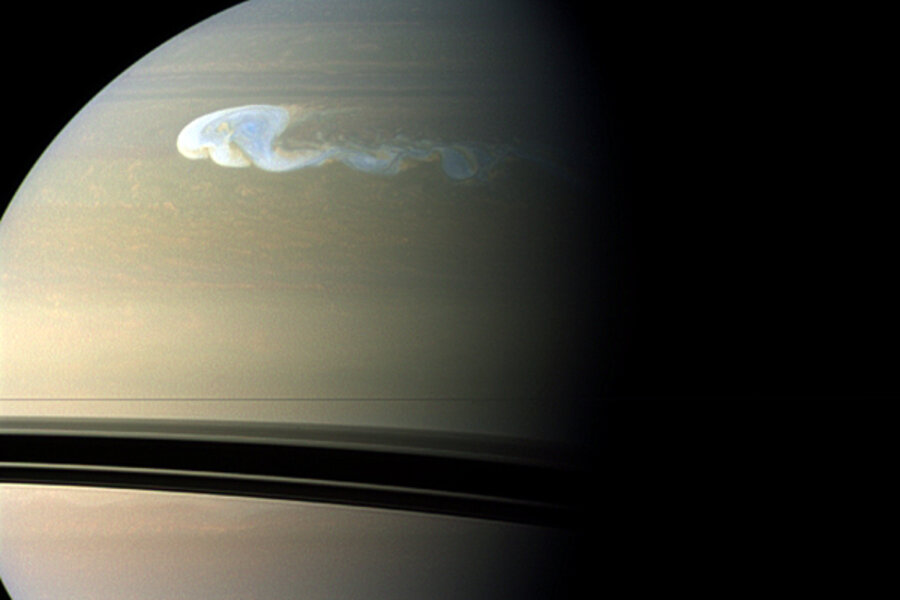Planets are basically gigantic cosmic dust bunnies, new study says
Loading...
Every home has nooks and crannies where dust bunnies form and grow. The same may hold true for budding solar systems, which might not form planets without cosmic dust traps, according to a new study.
The research suggests that vortexes in the extended disks of dust and gas surrounding young suns can corral tiny dust grains long enough to allow them to coalesce into objects big enough to stand a good chance of surviving to planethood.
If the work holds up to further scrutiny, it could help astrophysicists solve a longstanding planet-formation puzzle, according to the team reporting its results in Friday's issue of the journal Science.
Current models of planet formation generally build rocky planets, or the rocky cores of gas giants, by accreting material from a protoplanetary disk's inventory of gas and dust grains. These grains initially are less than a millionth of a meter wide. Over a span of about 10 million years, a disk's typical lifetime, such tiny particles eventually gather themselves into objects with up to 10 times Earth's mass, the researchers say.
The problem? Once the grains reach size scales ranging from a millimeter to a meter across, they tend to collide and break up. Or they experience aerodynamic drag from the material in the disk, slow down, and begin to fall in toward their host star, the researchers explain. Objects about 1 meter across tend to get drawn to the star if they are within 1 astronomical unit (AU), or about 93 million miles, from their star. At 50 AU, grains as small as 1 millimeter begin their death spiral.
Without something to stall that migration, accretion stalls and no planets form. Could large "dust traps," which theorists had proposed earlier, be an answer?
Nienke van der Marel, a PhD candidate in astronomy at the Leiden Observatory at the University of Leiden in the Netherlands, and colleagues turned to a well-studied protoplanetary disk to see what light it might shed on the question.
The disk surrounds a young star known as Oph ITS 48, about 390 light-years from Earth in the constellation Ophiuchus.
Past observations of the disk revealed a relatively dust-free sector attributed to a large planet sweeping up material in its path. Ms. van der Marel and her colleagues were interested in the distribution of millimeter-scale dust in the disk – the low end of the problematic size range.
Other observations at millimeter wavelengths hinted at the presence of a concentrated blob of millimeter-scale particles gathered in one region of the disk. But the observations weren't detailed enough to know "if it was real or an artifact," says Til Birnstiel, a researcher at the Harvard-Smithsonian Center for Astrophysics in Cambridge, Mass., and a member of the team reporting the results.
So the team used the new Atacama Large Millimeter Array (ALMA) high in Chile's Atacama Desert to make additional, more-detailed observations. The data revealed a crescent-shaped concentration of millimeter-scale dust some at a distance of between 45 and 80 AU from Oph ITS 48. This stood in stark contrast to the micron-sized grains and to gas, which were far more uniformly distributed throughout the disk.
Running a "dust trap" model to see if it could explain the observations, the team found that it could. The researchers propose that the planet clearing out the dust-free gap in the inner ring is generating turbulence in the gas along the edges of its path. On the outside edge, this turbulent "wake" is herding the millimeter-scale grains into a vast vortex-like dust trap. They can't break through it to continue their inward migration.
It takes only about a 10 percent change in the density of the gas in a vortex to set up a 100-fold increase in the density of the dust, according to the researchers. A relatively small vortex may last for only about 100,000 years, but the dust concentrations themselves can linger for millions of years before dispersing completely. A vortex as immense as the one at Oph ITA 48 could last for quite a while.
Mr. Birnstiel cautions that the calculations the team performed were relatively crude – in effect to see if the "dust trap" model had the potential to explain what the team observed. At Oph ITS 48, the dust trap is so far removed from the star than anything forming inside it will be more akin to the planetesimal-scale objects in the Kuiper Belt in our solar system than to planets, he says.
In addition, the observations of Oph ITS 48 raise something of a chicken-and-egg conundrum, suggests Philip Armitage, an astrophysicist at the University of Colorado at Boulder. Dust traps don't solve the original planet-formation problem if it takes a planet plowing through a protoplanetary disk to generate them, he writes in a commentary on the results, also appearing in Friday's issue of Science.
For now, the presence of a planet in the system is the most straightforward explanation for generating the vortexes that would trap dust, Birnstiel says. But it may not be the only one.
"It could be some kind of internal mechanism which is at work" in the disk, he says. Whatever it is, "you would need something that is persistent, that keeps perturbing the disk all the time."
As the final dish-shaped antennas at ALMA are brought on line, the team hopes to make more detailed observations if the inner disk at Oph ITS 48 as well as additional observations of its outer disk. These will provide important tests for the dust-trap hypothesis, Birnsteil says.







